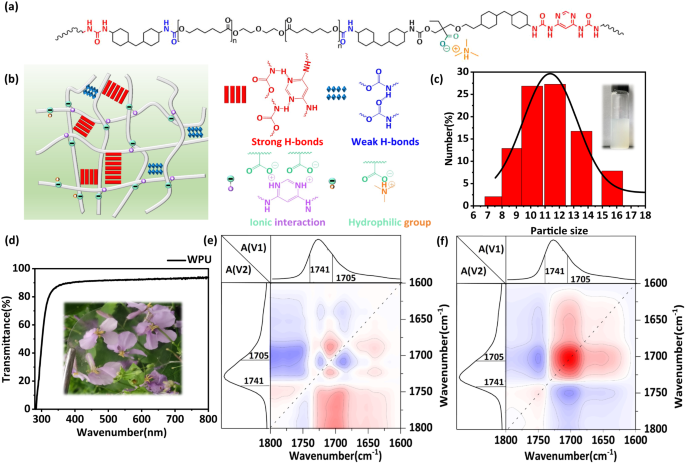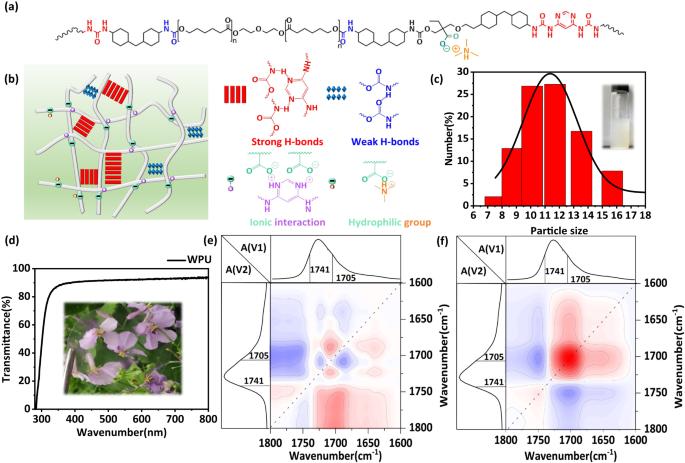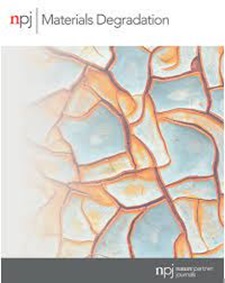基于高取向氧化石墨烯的生物启发自修复和防腐蚀水性聚氨酯涂料
IF 6.6
2区 材料科学
Q1 MATERIALS SCIENCE, MULTIDISCIPLINARY
引用次数: 0
摘要
面对无处不在的腐蚀威胁,开发具有主动自修复功能的高性能弹性体保护材料极具挑战性,意义重大。我们提出了一种将 WPU 弹性体与 GO 结合的方法,以创建具有界面氢键的多功能珠光层结构聚合物。通过氢键阵列交联聚己内酯二元醇(PCL)链,成功合成了具有高机械强度、延伸性、弹性、优异的抗损伤和愈合性能的弹性体。该弹性体具有显著的机械性能,包括 39.89 兆帕的拉伸强度、300.3 兆焦耳/立方米的韧性值和 146.57 千焦/立方米的断裂能。这种弹性体之所以具有更强的抗破坏性,是因为可分解的氢键阵列以及应变引起的 PCL 碎片结晶,从而有效地消散了能量。重要的是,由于氢键阵列的可逆性,断裂的 WPU 很容易愈合,并在 50 °C 下加热时恢复其原有的机械性能。此外,GO 的光热特性还能使生物仿生聚合物涂层在经过 30 秒的近红外照射后实现损伤恢复。所获得的仿生物涂层呈现出高度取向的层状结构,从而大大提高了物理阻隔性能和防腐蚀性能。电化学阻抗光谱(EIS)显示,其阻抗模量比空白涂层高出一个数量级。此外,扫描振动电极(SVET)证实了仿生物涂层在 3.5 wt% NaCl 溶液中的自修复性能和保护效果也是可靠的。这种高度可靠的仿生物涂层为在恶劣环境中创造多功能、高性能的智能材料提供了一种革命性的解决方案。本文章由计算机程序翻译,如有差异,请以英文原文为准。


Bio-inspired self-healing and anti-corrosion waterborne polyurethane coatings based on highly oriented graphene oxide
In the face of ubiquitous corrosion threats, the development of high-performance elastomer protective materials with active self-healing functions is extremely challenging and significant. We propose an approach by combining WPU elastomer with GO to create the multifunctional pearl layer structured polymers with interface hydrogen bonds. By crosslinking the polycaprolactone diol (PCL) chain with a hydrogen bond array, the elastomer with high mechanical strength, extensibility, elasticity, excellent damage resistance, and healing properties was successfully synthesized. The elastomer exhibits remarkable mechanical properties, including a tensile strength of 39.89 MPa, toughness value of 300.3 MJ m−3, and fracture energy of 146.57 kJ m−2. The enhanced damage resistance of the elastomer can be attributed to the decomposable hydrogen bond array as well as the strain-induced crystallization of PCL fragments, which effectively dissipate energy. Importantly, due to the reversibility of the hydrogen bonding array, the fractured WPU can easily heal and restore its original mechanical properties when subjected to heating at 50 °C. Moreover, the photothermal properties of GO enable the biomimetic polymer coating to achieve damage recovery after being irradiated with NIR for 30 s. The obtained biomimetic coating exhibits a highly oriented lamellar structure, thereby greatly enhancing physical barrier performance and anti-corrosion performance. Electrochemical impedance spectroscopy (EIS) shows that the impedance modulus is one order of magnitude higher than that of the blank coating. Additionally, scanning vibrating electrode (SVET) confirmed that the self-healing performance and protection effect of the biomimetic coating in 3.5 wt% NaCl solution were also reliable. This highly reliable biomimetic coating presents a revolutionary solution for creating multi-functional, high-performance smart material in harsh environments.
求助全文
通过发布文献求助,成功后即可免费获取论文全文。
去求助
来源期刊

npj Materials Degradation
MATERIALS SCIENCE, MULTIDISCIPLINARY-
CiteScore
7.80
自引率
7.80%
发文量
86
审稿时长
6 weeks
期刊介绍:
npj Materials Degradation considers basic and applied research that explores all aspects of the degradation of metallic and non-metallic materials. The journal broadly defines ‘materials degradation’ as a reduction in the ability of a material to perform its task in-service as a result of environmental exposure.
The journal covers a broad range of topics including but not limited to:
-Degradation of metals, glasses, minerals, polymers, ceramics, cements and composites in natural and engineered environments, as a result of various stimuli
-Computational and experimental studies of degradation mechanisms and kinetics
-Characterization of degradation by traditional and emerging techniques
-New approaches and technologies for enhancing resistance to degradation
-Inspection and monitoring techniques for materials in-service, such as sensing technologies
 求助内容:
求助内容: 应助结果提醒方式:
应助结果提醒方式:


